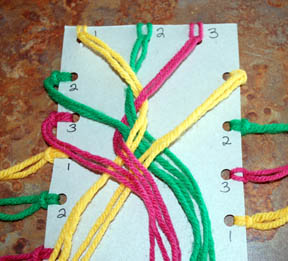French braiding dry hair is easier than wet hair because it is easier to divide the sections of hair for adding in. Also the hair is more cooperative because it doesn't make so many bumps and ridges. Wet hair wants to stay the way it is combed, but when you are adding hair to the braid you are changing the direction the hair lays, so wet hair is more troublesome. Making a single french braid down the middle of the head is slightly more difficult, in my opinion, than two french braid pigtails. The sections you have to gather in are longer and may be harder to keep in your hand while you are learning the fingering. Pigtails are twice as much work, though, since you have to do two. I'll teach both; you choose.
For pigtails, start by parting the hair down the middle. Secure one side temporarily to keep it out of the way. Gather a section of hair from the top and split it into three pieces. Start with a side-over-middle cross, but it is easier later on if you start with the side that is closer to the part. Add some hair in with each crossover. Use your fingers or a comb to gather a rectangular section of hair. Continue until there is no more hair to add in, then finish with a regular braid.
Fingering is the trickiest part to learn, and also the trickiest part to teach. It is not an exact science, and each pass may be different than the last. Do whatever you need to to keep the hair from falling out of your hands. You will need to keep each section separated, sometimes all in one hand. When crossing over, you may hold the piece going over the top between your pointer and thumb and reach under with your middle finger to grab the middle section to be crossed over.
Watch carefully that you do not cross the same side twice (R L R R). This is a common mistake for beginners. Keep your pattern alternating (R L R L). If you make a mistake, it will not look as neat as it should. If you have to go backwards to fix it, you risk dropping everything and having to start over completely. Depending on your time, patience, and skill, it may be better just to let the mistake stay in.
All that said, here is a video.
Click here for the first french braiding lesson:
Part A: Concept.



























